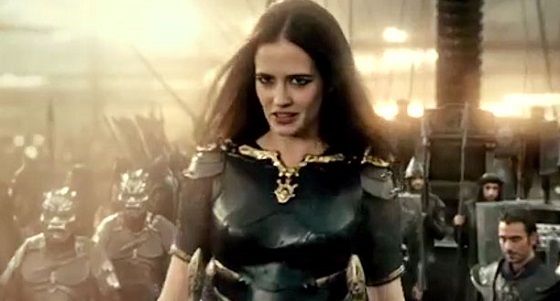 This review appears in slightly different form on Lawrence.com. Video from KCTV5 It’s Your Morning.
This review appears in slightly different form on Lawrence.com. Video from KCTV5 It’s Your Morning.
Using the overtly stylized, CGI-heavy parameters created by the director Zack Snyder’s 300 back in 2007, 300: Rise of an Empire, which is produced and co-written by Snyder, tells a broader story about the Greco-Persian Wars. Where the first film mainly covered the Battle of Thermopylae, where King Leonidas led 300 Spartans against 300,000 Persians, the new movie portrays lots of bloody battles that both preceded and followed 300.
Perhaps I shouldn’t have used the word “story” at all. Where 300 used the already clichéd Braveheart/Gladiator-style rallying speech seven years ago, 300: Rise of an Empire ups the ante with—count ‘em—four of these pre-battle pump-up moments. Hitting the same story beat four times in one movie isn’t very common (and a really bad idea), but 300: Rise of an Empire isn’t concerned with telling a story so much as it’s on a rinse-and-repeat cycle of purging as much dark crimson CGI blood as possible and one-upping the last big battle.
The tone of this violent, hard-R film is again dead serious, with Lena Headley (Game of Thrones) providing a heavy amount of portentous narration to tie the gratuitous battle scenes together as Queen Gorgo, Leonidas’s widow. The buff lead actor who gets to parade around in a cape and leather man-panties with his shirt off this time is Sullivan Stapleton as Greek leader Themistocles, who couldn’t be more milquetoast if he tried.
At least one member of the cast knows what kind of tawdry sleazefest she’s in, and that’s Eva Green. Perhaps the casting director saw Green ham it up as the lovestruck villain in Tim Burton’s otherwise dreary Dark Shadows, and knew the actress could instinctively breathe life into a two-dimensional role. As Artemisia, the only female commander of the Persian Navy, she retains a certain knowing glint in her eye as she does all kinds of unspeakable things aimed at driving middle-school-aged boys wild.
Director Noam Murro retains not only Snyder’s penchant and over-reliance on fetishized hyper-violence, but also the green screened videogame-looking backgrounds and slow-motion whip pans that made 300 famous. Since 2007, however, this style of action has become pretty commonplace, so most of 300: Rise of an Empire seems like old hat, even if some attempt has been made to make it darker—not just in terms of skies which never see the sun, but also in overall dreariness.
Putting on 3D sunglasses darkens the screen even more, of course, so I found myself removing them several times during the movie so I could see more clearly. That was also because of the confusing barrage of blurry backgrounds—which might have amplified the more “soft focus” soap-opera aspects of the story, had there been one. Flaming embers and tiny particles of dust float also around in almost every single scene to the point of distraction. I suppose they are meant to give depth to the 3D images, but there’s plenty of time during any number of hollow monologues about freedom for the mind to wander.
Even with a running time shorter than 300, this side-quel feels long, especially when Green isn’t onscreen. Snyder—the director who ruined Watchmen and Superman (and showed his true colors in the offensive faux girl-power man fantasy Sucker Punch)—has been called a visionary by his publicists, but 300: Rise of an Empire proves one thing for sure. If his “vision” can be this easily replicated by another director, he ought to get a new one.
Sidenote: The closing credit sequence features a JunkieXL remix of Black Sabbath’s “War Pigs” set to a short animation piece that’s more visually interesting than the movie itself.










{ 1 comment }
Nailed it.
Comments on this entry are closed.